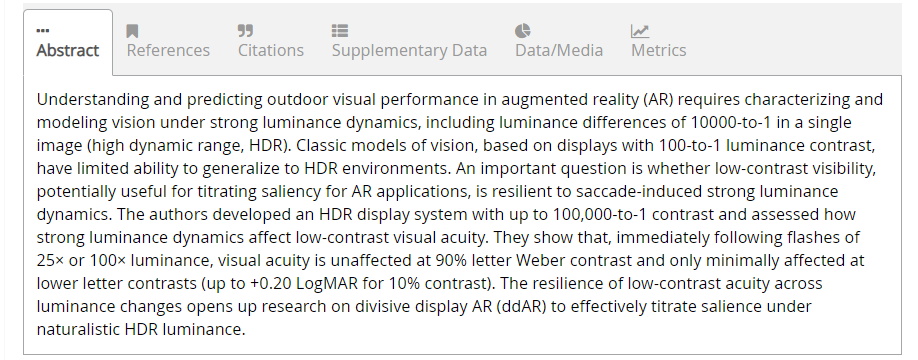Low-contrast Acuity Under Strong Luminance Dynamics and Potential Benefits of Divisive Display Augmented Reality
PubDate: Dec 2020
Teams: 1: Human Research and Engineering Directorate, US Army Research Laboratory, Aberdeen Proving Ground, MD 21005, USA 2: DCS Corporation, Alexandria, VA 22310, USA
Writers: Hung, Chou P. 1 ; Callahan-Flintoft, Chloe 1 ; Fedele, Paul D. 1 ; Fluitt, Kim F. 1 ; Vaughan, Barry D. 1 ; Walker, Anthony J. 1, 2 ; Wei, Min 1, 2 ;

Abstract
Understanding and predicting outdoor visual performance in augmented reality (AR) requires characterizing and modeling vision under strong luminance dynamics, including luminance differences of 10000-to-1 in a single image (high dynamic range, HDR). Classic models of vision, based on displays with 100-to-1 luminance contrast, have limited ability to generalize to HDR environments. An important question is whether low-contrast visibility, potentially useful for titrating saliency for AR applications, is resilient to saccade-induced strong luminance dynamics. The authors developed an HDR display system with up to 100,000-to-1 contrast and assessed how strong luminance dynamics affect low-contrast visual acuity. They show that, immediately following flashes of 25× or 100× luminance, visual acuity is unaffected at 90% letter Weber contrast and only minimally affected at lower letter contrasts (up to +0.20 LogMAR for 10% contrast). The resilience of low-contrast acuity across luminance changes opens up research on divisive display AR (ddAR) to effectively titrate salience under naturalistic HDR luminance.

